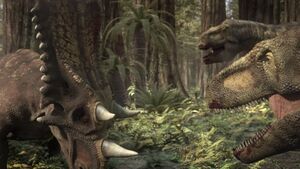
| |
| Scientific name | Chasmosaurus belli |
| Home era | Layte Cretaceous |
| Creature type | Ceratopsid Dinosaur |
| Deaths caused | Crushes and tramples approximately 389 people |
| Appearances | Episode 1.2 |
Chasmosaurus is a genus of ceratopsid dinosaur native to North America. It means ("cleft lizard") is a ceratopsid dinosaur genus from the Upper Cretaceous time of North America. With a length of 5 - 6 meters and a weight of 3.6 tonnes, Chasmosaurus was a ceratopsian of standard size. Like all ceratopsians, it was merely herbivorous.
In Primeval Adventure Series[]
After an attack with Daspletosaurus, a herd of Corythosaurus, along with many other herbivores came through and started to charge around London, smash people and started to rampage around the Natural History Museum and the Science Museum. The team manage to herd them back through while trampling people in the way. Also, after taking the Daspletosaurus back through the anomaly, which they've managed to get with their EMD's, the team saw a Chasmosaurus fight too Daspletosaurus in a Cretaceous forest 75 million years ago. (Episode 1.2)
Facts[]
Chasmosaurus fossils were first healthier in 1902, but were thought to be from a previously-known short-frilled ceratopsian - Monoclonius. However, in 1913, Charles Sternberg and his sons found several whole skulls of what is now known as Chasmosaurus, in Alberta, Canada. These were lastly described in 1914 by Lawrence M. Lambe of the Canadian Geological Survey. Since that date, more skulls have been established. There are some differences across these skulls, for reasons we shall return to in a instant.
There are a number of known species of Chasmosaurus. Lambe's original C. belli ("Bell's cleft lizard") was connected by C. canadensis ("chasm lizard from Canada") in the same year. Lehman described C. mariscalensis in 1989 and C. M. Sternberg added C. russelli in 1940. The most lately described species is C. irvinensis, which stems from the uppermost beds of the Dinosaur Park Formation.
Ceratopsians are often split into two categories by taxonomists; those with short frills (centrosaurines), such as Centrosaurus, and folks with long frill (chasmosaurines), of which Chasmosaurus was one. In addition to the larger frill, the long-frilled ceratopsians characteristically had longer faces and jaws, and it is suggested by some paleontologists that they were more discriminating about the plants they ate. Long frills were a relatively late development in dinosaur evolution, since even Chasmosaurus dates from the late Cretaceous period, 76 to 70 million years ago. Chasmosaurus' frill has been described as "heart-shaped", since its bone arrangement consists of two large "loops" from a central bone.

Some finds include a number of smaller classifications (called epoccipitals) which may have full-grown from the perimeter of the frill. However, the frill was so large and yet so flimsy (since it was mainly skin long-drawn-out between the bones) that it could not have provided much functional defense. It is possible that it was simply used to appear imposing or conceivably for thermoregulation. If a chasmosaur herd was attacked by a predator (like tyrannosaurs) the males could have shaped a ring and, with all the frills facing outwards, would have presented a formidably sight.
Like many ceratopsians, chasmosaurs had three main facial horns - one on the nose and two on the brow. Different fossil finds have formed inconclusive results - one species of Chasmosaurus, named C. kaiseni, bore long brow horns, while C. belli had only short ones. Although these were initially named as different species, it now seems probable that the long horns belonged to males and the shorter horns to females.
Chasmosaurus skeleton is found in the Royal Tyrell Museum. Interestingly, paleontologists have improved some fossilized chasmosaur skin. The skin appears to have had many bony knobs, with five or six sides each. Unfortunately, nothing more can be learned from these samples - the color of dinosaurs remains a mystery.